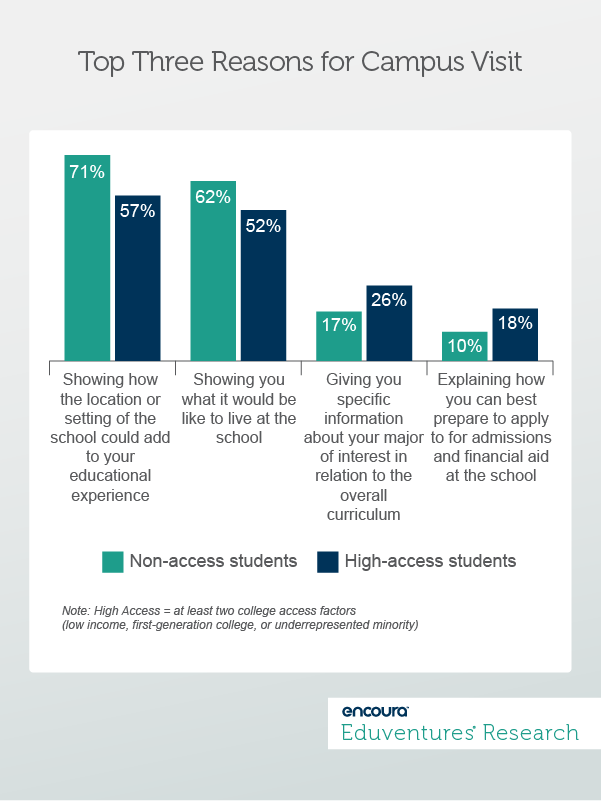Campus visits are the single best way for students and their families to get a feel for different kinds of schools as they begin their college search and make a final assessment on fit. In fact, nearly all students (89%) tell us that their visit to their enrolling school was
With this knowledge, institutions work hard to get their programs just right. One problem, however, stands in their way: long-standing and consistent disparities in the kinds of students who are able to make campus visits.
A Gap, Not a Chasm
Students with a college-going family history and financial means have historically visited colleges in larger numbers than those with what we call “access factors:” low-income, first-generation, and underrepresented minority status. Students who have two out of three access factors—high access students—face the greatest challenges in their ability to visit campus.
Our 2019 Prospective Student Survey shows this gap. Fourteen percent fewer high access population seniors, regardless of the type of institution the student believes they might attend, make an official campus visit during the application stage. And those who do visit a campus, make fewer visits than their non-access peers.
On the face of it, this disparity may not seem large, but underneath the data lie some important issues:
The Nature of the Visit Fundamentally Differs
The nature of the campus visit for high access students can be very different than for non-access students. A large proportion of official campus visits for high access students happen in the setting of an organized group visit, such as with a high school or an organization like Quest Bridge (Figure 1).

This means that high access students experience official campus tours less often with their families and more often with their peers, guidance counselors, teachers, or just by themselves. That makes for a fundamentally different kind of experience than travelling with a parent or family member, especially given the importance of the family decision in enrollment.
Is this the right decision framework for these students? Do you want to bring their families into the visit to a greater degree, and if so, how?
Unable to Drive-by
This disparity becomes far more extreme when it comes to the unofficial drive-bys that students do with their families, or informal overnights with siblings or friends at schools they attend. Few students in the high access groups make these kinds of visits at all. Thus it’s difficult for access students to get the unvarnished feel for the social life of a school in the same way their non-access peers do (Figure 2).

Different Reasons for Visiting Campus
Finally, regardless of their backgrounds, students are looking for many of the same things in a campus visit; they want to see what it would be like to live at the school and what the location and setting is like.
Still, high access students identify somewhat different reasons for campus visits. They are looking for students like them, and a bit more pragmatic information on majors and applications that non-access students may already feel they have covered (Figure 3).

Making Campus Visits More Accessible
Certain types of students are always going to visit campuses more than others. Institutions might never expect to close the gap entirely, but narrowing the gap should be a goal. Here’s what your campus can do right now to improve the access for students.
- Build solid partnerships with national and regional organizations that will bring students to campus. These should be some of the ones that are well known, but think also of specific partnerships in your recruiting regions.
- Fundraise for campus visit stipends and programs. Consider raising money to fund travel, not only for students, but also for a companion family members to make visits to your campus.
- Stimulate ways to get families on campus unofficially. Run programs that engage local families on your campus prior to junior or senior year through key feeder high schools. Think of creative ways to provoke unofficial visits for high access families.
- Make special connections to current students for high access students. On your campus visit registration form, ask if there are any special activities or groups students are interested in learning about. You don’t have to make promises, but, if you’re able to make a connection you’ll win.
- Offer easily accessible onsite admissions or financial aid counseling on visit days. Have an admissions counselor proactively available for one-on-one counseling after the official visit.
The data featured in today’s Wake-Up Call can be found in the Survey of Admitted Students app in Encoura Data Lab. For more information on how your institution can participate in the Survey of Admitted Students, contact us at contact@nrccua.org.
Thursday, July 18, 2019 at 2PM ET/1PM CT
When it comes to selecting technology, higher education leaders often face a choice between acquiring a single solution that spans across multiple functional areas – many of which we classify in our Tech Landscape as college-wide/enterprise-wide IT backbone solutions - or selecting solutions that address a single functional area.
Many times, the decision is informed less by technological features than about other issues, such as cost, fear of integration, and the desire to reduce the complexity of a technology ecosystem. In this webinar, we will discuss some factors institutions should consider when making this decision and touch on some alternatives to each approach.
Thank you for subscribing!
Thank you for subscribing!

